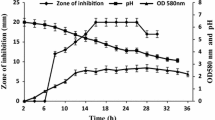Abstract
Urinary tract infections are the most common infectious diseases in babies and the elderly and are often acquired as nosocomial infections. The purpose of the present study was to identify strains of lactic acid bacteria (LAB) which could be used as alternatives to antibiotics for the treatment of urinary tract infections because of their ability to inhibit urinary tract pathogens (Klebsiella pneumoniae BCRC 10694 and Gardnerella vaginalis BCRC 17040). We screened 370 LAB strains using spent culture supernatants by inhibition zone assay to assess their antimicrobial effects. We studied the effect of heat, pH and enzyme treatment on the inhibitory activity of LAB strain supernatants. Anti-growth activity against urinary tract pathogens was evaluated by co-culture inhibition assay using seven LAB strains. Anti-adhesion and anti-invasion activities against urinary tract pathogens were evaluated by SV-HUC-1 uroepithelium cell culture. The results showed that the supernatants had good heat stability. However, antibacterial activity disappeared entirely at pH 7.0. After enzyme treatments, the supernatants showed first- or second-order inhibitory effects on K. pneumonia BCRC 10694. The survival rate of urinary tract pathogens was 0–10.65% and pH of the culture medium decreased after co-culture with LAB strains for 4 h. In a competition assay, PM2 and RY2 inhibited urinary tract pathogens. PM68, PM78, PM201, PM206 and PM229 inhibited the invasion of SV-HUC-1 cells by G. vaginalis BCRC17040. In conclusion, PM78, PM229 and RY2 showed the strongest inhibitory activity against urinary tract pathogens and could be suitable for use in the treatment of urinary tract infections.

Similar content being viewed by others
References
Salvatorea S, Salvatoreb S, Cattonia E, Siestoc G, Seratia M, Soricea P, Torellad M (2011) Urinary tract infections in women. Eur J Obstet Gynecol 156:131–136. https://doi.org/10.1016/j.ejogrb.2011.01.028
Dobrindt U, Hacker J (2010) Uropathogens and virulence factors. In: Naber KG, Scaeffer AJ, Heyns CF, Matsumoto T, Shoskes DA, Johansen TEB (eds) Urogenital infections, 1st edn. International Consultation on Urological Diseases (ICUD) and European Association of Urology, Arnheim (ISBN: 978-90-79754-41-0)
Jacobsen SM, Stickler DJ, Mobley HL, Shirtliff ME (2008) Complicated catheter-associated urinary tract infections due to Escherichia coli and Proteus mirabilis. Clin Microbiol Rev 21:26–59. https://doi.org/10.1128/CMR.00019-07
Damian M, Usein CR, Palade AM, Ceciu S, Cosman M (2009) Molecular epidemiology and virulence characteristics of Klebsiella pneumoniae strains isolated from hospital-associated infections. Open Epidemiol J 2:69–78
Harwich MDJ, Alve JM, Buck GA, Strauss JF, Patterson JL, Oki AT, Girerd PH, Jefferson KK (2010) Drawing the line between commensal and pathogenic Gardnerella vaginalis through genome analysis and virulence studies. BMC Genom 11:375–386. https://doi.org/10.1186/1471-2164-11-375
Schwebke JR, Muzny CA, Josey WE (2014) Role of Gardnerella vaginalis in the pathogenesis of bacterial vaginosis: a conceptual model. J Infect Dis 210:338–343. https://doi.org/10.1093/infdis/jiu089
Vick EJ, Park HS, Huff KA, Brooks KM, Farone AL, Farone MB (2014) Gardnerella vaginalis triggers NLRP3 inflammasome recruitment in THP-1 monocytes. J Reprod Immunol 106:67–75. https://doi.org/10.1016/j.jri.2014.08.005
Su CJ (2008) Female lower urinary tract infection. JTUA 19:12–20
Lamb N (2011) Can probiotics reduce urinary tract infections? Clinical Use Probiotics. https://doi.org/10.1097/CCM.0b013e31826a409c
Atassi F, Brassart D, Grob P, Graf F, Servin AL (2006) Lactobacillus strains isolated from the vaginal microbiota of healthy women inhibit Prevotella bivia and Gardnerella vaginalis in coculture and cell culture. FEMS Immunol Med Microbiol 48:424–432. https://doi.org/10.1111/j.1574-695X.2006.00162.x
Atassi F, Brassart D, Grob P, Graf F, Servin AL (2006) In vitro antibacterial activity of Lactobacillus helveticus strain KS300 against diarrhoeagenic, uropathogenic and vaginosis-associated bacteria. J Appl Microbiol 101:647–654. https://doi.org/10.1111/j.1365-2672.2006.02933.x
Uehara S, Monden K, Nomoto K, Seno Y, Kariyama R, Kumon H (2006) A pilot study evaluating the safety and effectiveness of Lactobacillus vaginal suppositories in patients with recurrent urinary tract infection. Int J Antimicrob Agents 28:30–34. https://doi.org/10.1016/j.ijantimicag.2006.05.008
Chapman CMC, Gibson GR, Todd S, Rowland I (2013) Comparative in vitro inhibition of urinary tract pathogens by single- and multi-strain probiotics. Eur J Nutr 52:1669–1677. https://doi.org/10.1007/s00394-013-0501-2
Kim SH, Wei CI (2007) Invasiveness and intracellular growth of multidrug-resistant salmonella and other pathogens in Caco-2 cells. J Food Sci 72:72–78. https://doi.org/10.1111/j.1750-3841.2006.00268.x
Yang E, Fan L, Jiang Y, Doucette C, Fillmore S (2012) Antimicrobial activity of bacteriocin-producing lactic acid bacteria isolated from cheeses and yogurts. AMB Express 2:2–48. https://doi.org/10.1186/2191-0855-2-48
Zhou F, Zhao H, Bai F, Piotr D, Liu Y, Zhang B (2014) Purification and characterisation of the bacteriocin produced by Lactobacillus plantarum, isolated from Chinese pickle. Czech J Food Sci 32:430–436. https://doi.org/10.17221/270/2013-CJFS
Poppi LB, Rivaldi JD, Coutinho TS, Astolfi-Ferreira CS, Piantino Ferreira AJ, Mancilha IM (2015) Effect of Lactobacillus sp. isolates supernatant on Escherichia coli O157:H7 enhances the role of organic acids production as a factor for pathogen control. Pesqui Vet Brasil 35:353–359. https://doi.org/10.1590/S0100-736X2015000400007
Machado A, Salgueiro D, Harwich M, Jefferson KK, Cerca N (2013) Quantitative analysis of initial adhesion of bacterial vaginosis-associated anaerobes to ME-180 cells. Anaerobe 23:1–4. https://doi.org/10.1016/j.anaerobe.2013.07.007
Boris S, Suárez JE, Vázquez F, Barbés C (1998) Adherence of human vaginal lactobacilli to vaginal epithelial cells and interaction with uropathogens. Infect Immun 66:1985–1989 (PMCID: PMC108154)
Wine E, Gareau MG, Johnson-Henry K, Sherman PM (2009) Strain-specific probiotic (Lactobacillus helveticus) inhibition of Campylobacter jejuni invasion of human intestinal epithelial cells. FEMS Microbiol Lett 300:146–152. https://doi.org/10.1111/j.1574-6968.2009.01781.x
Mappley LJ, Tchórzewska MA, Cooley WA, Woodward MJ, La Ragione RM (2011) Lactobacilli antagonize the growth, motility, and adherence of Brachyspira pilosicoli: a potential intervention against avian intestinal spirochetosis. Appl Environ Microbiol 77:5402–5411. https://doi.org/10.1128/AEM.00185-11
Reid G, Bruce AW (2003) Urogenital infections in women: can probiotics help? Postgrad Med J 79:428–443 (PMCID: PMC1742800)
Acknowledgements
This study was funded by the MOST 105–2632–B–241–001 project from Ministry of Science and Technology, Taiwan, R.O.C.
Author information
Authors and Affiliations
Corresponding author
Ethics declarations
Conflict of interest
The authors declare no conflict of interest.
Rights and permissions
About this article
Cite this article
Tsai, CC., Lai, TM. & Hsieh, YM. Evaluation of Lactobacilli for Antagonistic Activity Against the Growth, Adhesion and Invasion of Klebsiella pneumoniae and Gardnerella vaginalis. Indian J Microbiol 59, 81–89 (2019). https://doi.org/10.1007/s12088-018-0753-x
Received:
Accepted:
Published:
Issue Date:
DOI: https://doi.org/10.1007/s12088-018-0753-x




